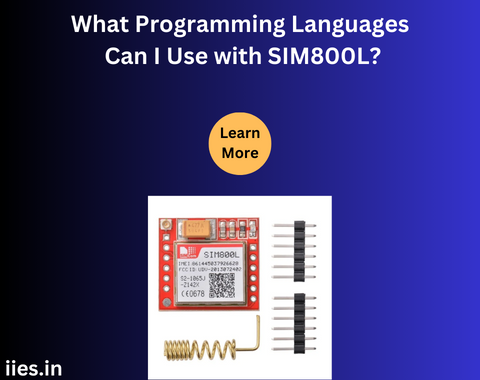
In the rapidly evolving landscape of Internet of Things (IoT), communication modules like SIM800L play a crucial role in connecting devices to the internet. These modules facilitate the transfer of data over GSM networks, enabling a wide range of applications, from remote monitoring to smart agriculture. As developers delve into the world of SIM800L, a common question arises: “What programming languages can I use with SIM800L?”
The SIM800L module, manufactured by SIMCOM, is a compact and versatile GSM/GPRS module designed for embedded applications. Its primary function is to establish a communication link between devices and the internet using GSM networks. Equipped with features like SMS, GPRS, and TCP/IP protocols, the SIM800L is a popular choice for IoT projects, wearable devices, and other applications that require wireless connectivity.
One of the most accessible ways to communicate with SIM800L is through AT commands. These commands are simple text instructions that can be sent to the module via a microcontroller or a computer’s serial interface. Arduino, with its extensive community support, is a popular platform for interfacing with SIM800L using AT commands. Developers can write Arduino sketches in C/C++ to control the module’s functionality, making it an ideal choice for those who are new to embedded systems.
Python:
Python, known for its readability and versatility, is another language that can be used to interact with SIM800L. Libraries such as `serial` can be employed to establish a serial connection between a Python script and the module. With Python’s ease of integration and vast ecosystem of libraries, developers can quickly prototype and implement various functionalities, from sending SMS to handling data communication over GPRS.
Embedded C:
For developers looking to optimize resource usage and have more control over low-level functionalities, embedded C is a powerful option. Writing code in C allows for efficient memory management and direct control over hardware interfaces. Microcontroller platforms like STM32, PIC, or AVR can be programmed in C to communicate with SIM800L, providing a lightweight and efficient solution for resource-constrained applications.
Java and Android:
Java, a versatile and platform-independent language, can also be employed in conjunction with SIM800L. Android developers, in particular, can leverage Java to create applications that communicate with the module. This opens up possibilities for developing mobile applications that interact with SIM800L-equipped devices, extending the reach of IoT projects to a broader audience through smartphones.
Node.js:
Node.js, with its event-driven and non-blocking architecture, is well-suited for applications that require real-time communication. Developers can utilize the `serialport` library to establish a serial connection between Node.js and SIM800L. This enables the creation of server-side applications that can communicate with and control SIM800L-equipped devices, making Node.js a compelling choice for IoT projects with a focus on responsiveness.
Raspberry Pi and Linux-based Languages:
For projects that demand the power of a single-board computer, Raspberry Pi can be an excellent choice. Programming languages such as Python, C, and even shell scripting can be used to interface with SIM800L on a Raspberry Pi. This combination is particularly advantageous for projects that require data processing, storage, and networking capabilities beyond the scope of microcontrollers.
Advanced Programming Languages and Frameworks for SIM800L
While the previously mentioned programming languages cover a broad spectrum of developers, there are more advanced options and frameworks that can provide additional features and capabilities when working with SIM800L.
Micro Python:
Micro Python, a lightweight implementation of Python 3 for microcontrollers, presents an intriguing option for developers who are comfortable with Python but are working with resource-constrained environments. It allows developers to write Python scripts directly on microcontrollers, providing a higher-level language for those who may find traditional embedded programming languages more challenging.
Modular Frameworks:
Frameworks such as Mongoose OS and PlatformIO offer a modular and flexible approach to IoT development. Mongoose OS, in particular, supports JavaScript, mJS (a JavaScript engine for microcontrollers), and C, allowing developers to choose the language that best fits their needs. PlatformIO, on the other hand, is an open-source ecosystem for IoT development that supports multiple platforms and frameworks, making it easier to manage dependencies and libraries.
Swift and iOS Development:
For developers immersed in the Apple ecosystem, Swift can be used to create iOS applications that communicate with SIM800L-equipped devices. This opens up possibilities for integrating IoT functionality seamlessly into the iOS environment, providing a cohesive experience for users. Swift’s modern syntax and powerful features make it an excellent choice for developers focused on building applications for Apple devices.
Go (Golang):
Known for its efficiency and simplicity, Go (or Golang) is gaining popularity in the realm of IoT. Go’s strong support for concurrency and ease of deployment make it a compelling choice for building scalable and efficient applications that interact with SIM800L. Developers can use the language to create robust server-side applications or even deploy Go code directly onto microcontrollers, depending on the project’s requirements.
LabVIEW:
For engineers and scientists who prefer a graphical programming approach, LabVIEW provides a visual programming language for developing applications that interact with hardware, including GSM modules like SIM800L. LabVIEW’s intuitive interface allows users to create complex applications without writing extensive lines of code,
In conclusion, the SIM800L module offers compatibility with a diverse range of programming languages, catering to the preferences and requirements of developers with varying levels of expertise. Whether you’re a beginner exploring Arduino, an Android developer working with Java, or an experienced embedded systems programmer using C, the versatility of SIM800L opens up a world of possibilities for IoT applications. As the field of IoT continues to grow, the ability to seamlessly integrate communication modules like SIM800L with different programming languages ensures that developers can choose the tools that best suit their needs, fostering innovation and creativity in the realm of connected devices.
Indian Institute of Embedded Systems – IIES